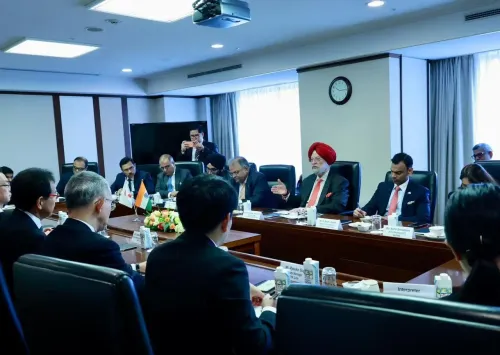Is South Korea Set to Boost US Shipbuilding Projects?

Synopsis
Key Takeaways
- South Korea is launching a consultative body to boost shipbuilding cooperation with the U.S.
- The initiative is expected to create new opportunities for Korean shipbuilders.
- South Korea has pledged significant investments in the MASGA project.
- Hanwha Ocean's LNG carriers symbolize South Korea's competitiveness in high-value markets.
- The MRO project represents a key aspect of bilateral defense collaboration.
Seoul, Aug 14 (NationPress) The South Korean administration is set to establish a consultative body comprised of relevant ministries to bolster the collaboration in shipbuilding with the United States, according to the industry minister's announcement on Thursday. This initiative aims to open up new avenues for the South Korean shipbuilding sector.
During the naming ceremony of two liquefied natural gas (LNG) carriers destined for the U.S. from the renowned Korean shipbuilder Hanwha Ocean Co., which took place at its shipyard in Geoje, located approximately 330 kilometers southeast of Seoul, Industry Minister Kim Jung-kwan shared insights about the plan, as reported by the Ministry of Trade, Industry and Energy.
"The government is committed to rapidly forming a consultative body that includes relevant agencies to support the Make American Shipbuilding Great Again (MASGA) initiative, while maintaining close communication with U.S. counterparts to achieve concrete outcomes," he mentioned, as per Yonhap news agency.
The MASGA initiative represents South Korea's proposal for a bilateral shipbuilding partnership with the U.S., introduced during tariff negotiations with the Donald Trump administration.
Recently, the Seoul government secured a trade agreement with the Trump administration, pledging to invest US$150 billion in the MASGA initiative along with an additional $200 billion for collaborative efforts in strategic sectors such as semiconductors, batteries, and biotechnology.
Minister Kim emphasized, "MASGA is a mutually beneficial project that invigorates the U.S. shipbuilding industry by promoting investment in American shipyards, while also assisting in workforce development and supply chain reconstruction." He added, "This endeavor will also provide our companies with fresh opportunities to penetrate new markets."
According to the ministry, the LNG carriers recently built by Hanwha Ocean are the first two out of five vessels that will be delivered to the U.S. for its LNG export requirements. Hanwha secured this $1.2 billion contract in 2022.
The deal underscores the exceptional competitiveness of South Korean shipbuilders in the high-value LNG carrier sector, with the ministry noting that over 70 percent of the 760 LNG carriers currently in operation globally have been constructed by South Korean firms.
Remarkably, in the first half of this year, South Korean companies achieved a 100 percent share of global LNG carrier orders, as highlighted by the ministry.
Following the naming ceremony, Minister Kim also engaged with officials from Hanwha Ocean and crew members of the U.S. Navy vessel Charles Drew at the Geoje shipyard.
Hanwha Ocean is currently undertaking maintenance, repair, and overhaul (MRO) services for Charles Drew, marking it as the third U.S. naval vessel to receive MRO at the Hanwha facility.
Minister Kim remarked, "The MRO project for the U.S. naval vessel signifies the beginning of Korea-U.S. shipbuilding collaboration, and we anticipate that, similar to the previous two MRO projects, Charles Drew will emerge revitalized through the advanced capabilities of South Korean shipbuilding."
Last August, Hanwha secured an MRO contract for the U.S. Navy's logistics support vessel Wally Schirra, signifying a historic deal for a South Korean shipbuilder. In November, they also obtained an MRO contract for the replenishment oiler Yukon.
In another development, during his visit to the Geoje shipyard, Minister Kim announced that the government will unveil measures aimed at supporting the restructuring of the struggling petrochemical industry later this month, expressing confidence that the petrochemical sector can navigate its challenges, akin to the shipbuilding industry’s recovery in the late 2010s.









